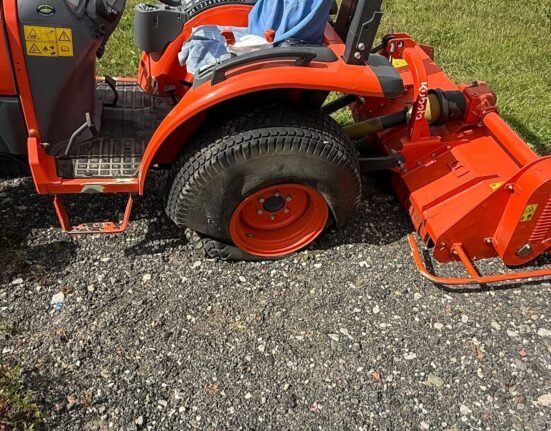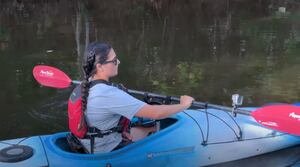Long stretches of sandy beach at Siyam World to stroll or horseback ride.
Siyam World
With its pristine white sandy beaches, scenic overwater villas and the surrounding cerulean-hued waters of the Indian Ocean, the Maldives attracts visitors from all over the world. So, it’s no wonder that water activities are the big draw for tourists to this island nation. But, three things that are sometimes overlooked: an eco ethic, a respect for local culture and land-based experiences. Thankfully, the family-owned Sun Siyam Resorts with five properties in the Maldives, embraces this trio of factors.
Siyam World has a variety of enchanting villas, including the Sunset Pool Beach Villa.
Siyam World
At Sun Siyam Resorts, sustainability is key, as it should be. After all, the Maldives are renowned for biodiversity, both on land and water. Of particular concern: the health of the coral reefs. They are vital for the diverse marine life but they’re threatened by climate change. Not only do these resorts embrace an eco-consciousness to help preserve biodiversity by, for example, reducing the use of plastics but they also promote renewable energy sources. Buying local produce — from nearby farm islands — is another way of reducing the carbon footprint while embracing sustainable farming practices. Furthermore, Sun Siyam Resorts is dedicated to social responsibility, employing locals and offering job opportunities that empower women and helps vitalize the economy. They also bring guests into intimate contact with Maldivian culture, providing an education in local traditions.
These are some of the many land-based activities you’ll find at three of the Sun Siyam Resorts, activities that will give you a better appreciation for flora and fauna (on land and in the ocean) as well as Maldivian culture and a green ethic that’s vital to the health of the Maldives.
Sun Siyam Vilu Reef
Sun Siyam Vilu Reef’s Grand Reef Suite offers stellar water views.
Sun Siyam Vilu Reef
As you wander around Sun Siyam Vilu Reef, you’ll notice that many of the accommodations and restaurants are snuggled by sea hibiscus, flame of the woods, giant crinum lily and other foliage.
Cooking Class
You can be as involved in the preparation as you want in the Cooking Class at Sun Siyam Vilu Reef.
Sun Siyam Vilu Reef
After guests finish their Cooking Class at Sun Siyam Vilu Reef, they enjoy sampling the dishes they created.
Sun Siyam Vilu Reef
Learn how to make Maldivian cuisine by signing up for a hands-on class that relies on mostly local ingredients. You’ll become familiar with some of the ingredients by, for example, tasting some of the herbs and spices before you get involved in the actual preparation and cooking. One typical Maldivian dish, for example, is tuna curry that’s made by first marinating the tuna steak with chiles, other herbs and spices (such as cardamon, curry leaf and turmeric) and coconut milk, and then wrapping it in a pandam leaf before setting it on the grill. You’ll also make the flavored rice and side tuna salad that it’s served with. And, of course, you’ll enjoy these delicacies when you’re done.
Wine Tasting
Guests enjoy wine tastings or a wine pairing dinner at Sun Siyam Vilu Reef.
Sun Siyam Vilu Reef
You’ll sample four wines — two red and two white — in this one-hour session that’s held in a spacious room that you can also reserve for a wine pairing dinner. With more than 1,000 wines on hand, you’ll have the opportunity to learn about those from as far away as Chile and Hungary and find out how they pair with different cheeses. For example, a crisp, delicate Riesling may pair well with a Gorgonzola. Likewise, a pinot noir from Hungary that’s replete with strawberry and raspberry notes can be served chilled, and paired with a mozzarella.
Traditional Village Experience
Guests who sign up for breakfast at the Cultural Village at Sun Siyam Vilu Reef learn about traditional Maldivian culture, architecture and cuisine.
Sun Siyam Vilu Reef
Guests can indulge in this very different breakfast experience that takes place at a recreated traditional Maldivian village complete with a beachfront house or Athireege. You’ll notice the thatch dwelling that’s occupied by a simple bed with a cotton mat atop as well as an outdoor area with a wooden lounge chair strung with rope, a wooden bench and a bench swing, where the family could enjoy the ocean breeze and where the grandmother could teach the younger ones. There would also be a garden planted with lemongrass, panda and curry leaves, as well as Maldivian roses. For this experience, a buffet consisting of traditional Maldivian breakfast fixings await on a table outside, and may include sweet and sour fish (rihaakuru) and chili chicken. Five items served at every Maldivian meal can be found on the table: chiles, coconut, tomatoes, cucumbers and limes. And, of course, there are fruits aplenty, such as watermelons, pineapples, mangos and passion fruits. Most everything is served in a bowl made from a colorfully-painted coconut shell.
Mixology Class
Pick an alcoholic beverage or mocktail that you enjoy and see how simple it is to create this drink in the Cocktail class at Sun Siyam Vilu Reef.
Sun Siyam Vilu Reef
Whether you prefer a cocktail with a kick or a virgin beverage, you’ll be able to go behind the bar and learn how to mix your drink(s) of choice. As far as mocktails go, the Kurumba Colada is quite refreshing, made with fresh pineapple juice, coconutk water, coconut cream and coconut pulp. Like all the bartending recipes here, this one is quite simple: you put the pulp in the blender, add the coconut water and cream, and the juice and pour it all into a pineapple and sip with a straw. There likely will be canapes to enjoy as well, such as dates with sunflower cream.
Local Island Tour
On Bandidhoo Islands, you’ll see the banyon trees and other foliage that create a jungle-like ecosystem at Sun Siyam Vilu Reef
Sun Siyam Vilu Reef
A short ride on a speed boat takes guests to Bandidhoo, a small local island where you’ll have a window into daily life. (Just 700 to 800 people reside here.) As you walk along the unpaved roads with your guide, you’ll see chickens crossing your path and pass the school (first through 10th grades) where the children learn English as well as, of course, the mother tongue of Dhivehi. You’ll notice that wealthier residents have gated properties with lush gardens growing guava, breadfruit and mango.
A jungle-like section of the island is dense with banyan trees draped with aerial roots that the kids make into a swing. On the nearby beach, crabs scurry about — fishermen use them as bait to catch snapper and other reef fish. Your guide continues the tour, where you’ll spot the clinic that has one doctor on staff. One of the two mosques is quite old with a 100-some-year-old sundial outside. At the pier, before getting back on the boat, you’ll notice a family park created by Sun Siyam’s owner. Here, the community can enjoy the gym equipment, swings, slides and much more.
On the Local Island tour, Sun Siyam Vilu Reef, you’ll see two mosques, including one that’s quite old.
Sun Siyam Vilu Reef
Farm Tour
Produce is grown organically on the Farm Island at Sun Siyam Vilu Reef.
Sun Siyam Vilu Reef
The speed boat docks at this small island that grows organic produce for a few of the Sun Siyam properties. Dozens of different types of fruits, vegetables and herbs are cultivated, such as lemongrass, basil, papayas, melons, chiles and bananas. Lettuces are grown hydroponically. If you’re lucky, maybe you’ll spot a fruit bat that especially loves passion fruit.
Sun Aqua Spa
Guests luxuriate at the Spa at Sun Siyam Vilu Reef.
Sun Siyam Vilu Reef
You’ll have myriad treatments to choose from at the Sun Aqua Spa at Sun Siyam Vilu Reef.
Sun Siyam Vilu Reef
With the spa offering more than a dozen types of massages, you’re bound to find a treatment that suits your particular needs. Among the massages available: the herbal massage using sun-dried ingredients, the Balinese massage that relies on acupressure and aromatherapy and their signature two-hand massage. If you’d rather indulge in a luxuriating exfoliation, you may want to try the Javanese Lulur Scrub that blends turmeric and other herbs and spices with coconut oil. It’s ultra moisturizing. Then step outside: the shower is surrounded by lush foliage.
Sun Siyam Iru Fushi
There are so many intimate accommodations at Sun Siyam Iru Fushi, including the Pool Beach Villa.
Sun Siyam Iru Fushi.
Nature Walk
The Nature Tour at Sun Siyam Iru Fushi offers guests insights into flora and fauna.
Sun Siyam Iru Fushi.
A Nature Tour with a biologist is an idyll way to learn about flora and fauna at Sun Siyam Iru Fushi.
Sun Siyam Iru Fushi.
For those who gravitate to horticultural or field biology experiences, sign up for a Nature Walk where a biologist leads a 45-minute trek through the verdant grounds. You’ll come away with an education on the types of flora and fauna found at Sun Siyam Iru Fushi. You may even spy a fruit bat known as the flying fox bat ( especially love the fruit of the sea almond tree); hear the loud krrrr sounds of koel birds; or notice a garden lizard scurrying on the ground.
Your guide will point out how every part of the coconut palm — the national tree of the Maldives — is used: the wood for home building; the roots for its anti-inflammatory properties; the young flower is edible; roofing material comes from the leaves; while the stalk leaves can be fashioned into a broom. There are many screw pines on the grounds, trees that prevent coastal erosion; the white breasted waterhen, the national bird, uses the tree’s aerial roots as a nest. Another plant that helps prevent erosion is the beach gardenia; the leaves can even be used as a plate. You’ll learn that sunburn can be treated with the flesh of sea lettuce fruit while neem — a tree that’s good for a host of ills — can be used for skin allergies by first crushing the leaves and applying it to the irritation.
Coral Reef Restoration
Those who sign up for the Coral Restoration get a hands on experience at Sun Siyam Iru Fushi.
Sun Siyam Iru Fushi.
In this hands-on class, you’ll be working with a marine biologist who has already collected coral fragments in different sizes and shapes from the surrounding waters. The idea is to attach each of the fragments of two different coral species — Acropora and Pocillopora — to a pyramidal-shaped rebar frame.
After all the rebar frames are full of coral fragments, the marine biologist at Sun Siyam Iru Fushi dives and places them into the water.
Sun Siyam Iru Fushi.
Once the frame is full of the attached coral fragments, at another time, the marine biologist will dive and put the frame into the water at a depth of about 16 to 26 feet. (They try to place three to four frames in the water per month.) Then, every two weeks, the biologist checks on the coral to make sure algae don’t infiltrate the frame, hindering their growth. Interestingly, almost immediately after planting the frame in the water, there’s an increase in marine life around the coral, such as puffer fish and rays. However, coral grows slowly: for Acropora, it’s about 4 to 6 inches a year; and Pocillopora is even slower: 3 to almost 5 inches annually.
The Spa
The spa is surrounded by lush foliage at Sun Siyam Iru Fushi.
Sun Siyam Iru Fushi.
Guests enjoy walking along the reflexology paths at the Spa at Sun Siyam Iru Fushi.
Sun Siyam Iru Fushi.
Serenity is ever present at the Spa at Sun Siyam Iru Fushi.
Sun Siyam Iru Fushi.
A network of curvy, overwater, pebble-inlaid paths weave this way and that to the treatment rooms as well as the al fresca yoga pavilion. Walk on them barefoot for an invigorating reflexology workout; the sounds of water bubbling over the sides of large urns enhance the experience. Guests delight in this spa that brims with a vast array of treatment options, around 165 of them. Each of the 20 treatment rooms are named for flowers — orchid, lotus, hibiscus, for example — with that blossom’s delicate fragrance infused in the air.
Guests enjoy the placid vibe at the Relaxation Area at the Spa at Sun Siyam Iru Fushi.
Sun Siyam Iru Fushi.
Anyone who signs up for a treatment can enjoy the open-air hydrotherapy area that’s complete with a sauna, steam bath as well as warm and cold pools. Before or after your treatment, you’ll want to spend time in the al fresco relaxation area that faces the overwater pebble paths. Here, you can sip a citrus cooler made with orange and pineapple juices along with fresh mint leaves or a green smoothie that’s a blend of green apples, cucumber and ginger. Guests who want to address a particular difficulty can sign up for a consultation with an Ayurvedic doctor.
Painting and Bracelet Making Classes
Bracelet making class at Sun Siyam Iru Fushi is perfect for creating an authentic souvenir.
Sun Siyam Iru Fushi.
Guests who sign up for the painting class at Sun Siyam Iru Fushi come away with another lovely souvenir.
Sun Siyam Iru Fushi.
Kids and adults alike can use their creativity in these classes, where you’ll be guided through the use of acrylic paints and coconut husk-derived coir rope. In the painting class, you’ll be able to use your imagination to paint a tropical scene on a tiny plywood surfboard that you can bring home as a souvenir.
Another souvenir you can make is a bracelet created from coconut husk-derived coir rope. It has a natural brown color but you can also weave it together with colorful cotton cord so it’s more vibrant.
Siyam World
Siyam World has accommodations for all demographics, including the Grand Water Pavilion that will suit families with kids.
Siyam World
The Two Story Beach Residence with Pool at Siyam World wraps guests in serene luxury.
Siyam World
The network of sandy paths at Siyam World are perfect for cycling.
Siyam World
As the newest of the Sun Siyam Resorts in the Maldives, Siyam World is also the most surprising in terms of breaking the Maldivian activity mold. You probably, for example, wouldn’t expect to find a riding center with Marwari horses, a breed that can deal with the sweltering climate; electric go-kart racing; or e-Mokes that you can rent — mini versions of one of James Bond’s cars that he drove in Live and Let Die and a few other 007 movies.
Whether riding on the beaches or the sandy paths, horseback riding at Siyam World is idyllic.
Siyam World
Yet, this expansive property that’s networked with sandy roads has so many eclectic and unexpected offerings, it appeals to honeymooners, families with young kids and just about everyone else. While it’s too big to easily and comfortably walk around the entire property, Siyam World relies on a network of purple-colored buggies — kinda like long golf carts — that stop all over the resort, including at bus “terminals” that are decorated like venues from around the world. Here are a few of the laid-back land-based activities.
Art Classes
Art Studio at Siyam World offers guests the opportunity to explore their creativity and take home their painting as a souvenir.
Siyam World
Even if you don’t consider yourself artistically talented, it’s worth signing up for a painting class in this small studio where light streams in through broad windows. The walls are hung with mostly tropical paintings, including those surreal works created by the instructor who hails from Nepal. He helps motivate the guests to paint what interests them, suggesting the appropriate brushes, colors and techniques to best create depth and texture. (You’ll be able to take your art home with you as a souvenir to remind you of the Maldives.)
Wine Tasting at Barrique
Even the entrance at Siyam World’s Barrique is unique.
Siyam World
Even the entry to Barrique, a contemporary underground wine cellar, is unique, down a steep-ish flight of stairs flanked by walls that resemble a mosaic of different sorts of wood. Each of the duo of circular tasting rooms is embellished with a domed, conical ceiling, with wooden ribbing.
The subdued lighting at Siyam World’s Barrique is perfect for a wine tasting or wine pairing dinner.
Siyam World
With numerous candles and sconces, one of the pair of rooms has more subdued lighting, perfect for an intimate tasting or a wine dinner. If you sign up for the former, you’ll taste three to five different wines during the session that lasts at least an hour, depending on the number of people and their questions. The cellar stocks around 120-some labels, with wines sourced from 16 different countries, including India, Thailand and China. During the tasting, you’ll be prompted to see how a given wine pairs with a range of different foods, such as Danish blue and feta, cured salmon, house cured tuna and dark chocolate.
At Siyam World’s Barrique, the sommelier will discuss how different wines enhance the flavor of a variety of different foods.
Siyam World
Various foods, including cheeses, can be sampled while sipping wine at Siyam World’s Barrique at Siyam World.
Siyam World
The sommelier will explain how, for example, a full-bodied Gruet — a unique sparkling wine that’s fruit-forward — can enhance the flavor of a Swiss cheese or diminish the flavor of a Cheddar; a Gruner Vetliner noted for its grassy notes can reduce the saltiness of the smoked salmon; and a Gruad-Larose, a very smooth red, can dampen the intensity of a blue cheese.
Veyo Spa
The Veyo Spa at Siyam World is noted for many things, including the network of reflexology paths.
Siyam World
The treatment rooms at the Veyo Spa at Siyam World bring the outside in.
Siyam World
Guests delight in the foliage-lined paths at the Veyo Spa at Siyam World.
Siyam World
The extensive gardens of the Veyo Spa are threaded with myriad pebbled reflexology paths that couldn’t be more therapeutic. In fact, once a week, guests can participate in a barefoot power walk. And, like so many things at Siyam World, the spa has some unique or unexpected offerings, such as Laughing Yoga, Kids Yoga, Reiki and Maldivian Cowrie Shell Massage — it’s the shell of a sea snail. Sound healing, for example, is a mindfulness practice that many people may not be familiar with.
The Veyo Spa Plunge Pools at Siyam World are very refreshing.
SIyam World
The Sound Healing session at the Veyo Spa at Siyam World may be a unique experience for some.
Siyam World
The spa holds a 60-minute sound healing session using crystal singing bowls, though Tibetan bowls can be used instead. When each of the bowls is struck or the mallet is rolled along the rim, it produces sounds and vibrations that are said to stimulate (and unblock) different energy centers in the body, referred to as chakras. (Guests are informed about how the bowls work and which chakra each is associated with, whether the heart, solar plexus or throat, for example.)
Another traditional healing method is SuJok, where “Su” is Korean for “hand” and “Jok” means “foot.” This is an acupressure technique to restore balance and enhance physical and mental well being. It starts with a foot soak in warm water with floating hibiscus petals and then a light scrub with pink Himalyan salt followed by a massage with coconut cream. Other wellness, mindfulness or rejuvenating treatments include sunset meditation, mat pilates, Ayurvedic massage, and a Couples Retreat that involves a coconut oil massage, followed by a honey cucumber facial and then a bubble bath where you and your partner will be offered a glass of sparkling wine.







